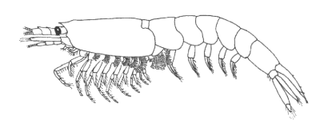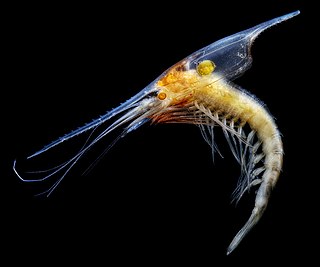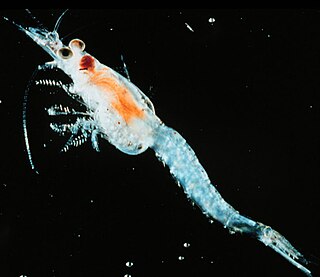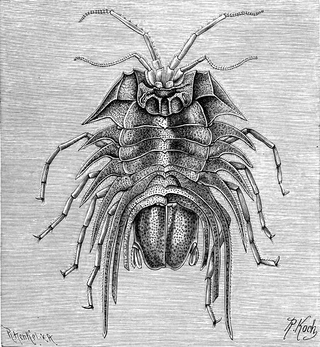
Mysidae is the largest family of crustaceans in the order Mysida, with over 1000 species in around 170 genera.

Bentheuphausia amblyops, the deep sea krill is a species of krill. B. amblyops is the only species within its genus, which in turn is the only genus within the family Bentheuphausiidae. All the 85 other species of krill known are classified in the family Euphausiidae.
Stylocheiron is a genus of krill, containing the following species:

Lophogastrida is an order of malacostracan crustaceans in the superorder Peracarida, comprising shrimp-like animals that mostly inhabit the relatively deep pelagic waters of the oceans throughout the world.

The Hyperiidea are a suborder of amphipods, small aquatic crustaceans. Unlike the other suborders of Amphipoda, hyperiids are exclusively marine and do not occur in fresh water. Hyperiids are distinguished by their large eyes and planktonic habitat. Most species of hyperiids are parasites or predators of salps and jellyfish in the plankton, although Themisto gaudichaudii and a few relatives are free-swimming predators of copepods and other small planktonic animals.

Cyclops is one of the most common genera of freshwater copepods, comprising over 400 species. Together with other similar-sized non-copepod fresh-water crustaceans, especially cladocera, they are commonly called water fleas. The name Cyclops comes from the Cyclops of Greek mythology, as they have a single large eye; in Cyclops, the eye may be either red or black.

Mysis is a genus of mysid crustaceans in the family Mysidae, distributed mainly in the coastal zone of the Arctic and high boreal seas. Several species also inhabit northern freshwater lakes and the brackish Caspian Sea. Fifteen species are recognized. Body lengths range from 1 to 3 centimetres.
Boeckella is a genus of copepods in the family Centropagidae.

Epischura is a genus of copepods in the family Temoridae.

Gnathophausia zoea is a species of lophogastrid crustacean. It is widely distributed in the Atlantic Ocean from the Arctic Circle to the Equator; in the Pacific Ocean, it is more restricted to tropical areas. The adults may reach 40–50 millimetres (1.6–2.0 in) long, excluding the rostrum, or around 70 mm (2.8 in) including the rostrum.
Rudolf von Willemoes-Suhm was a German naturalist who served aboard the Challenger expedition.

Praunus is a genus of mysid shrimp, comprising three species:
Gnathophausia ingens, the giant red mysid, is a species of lophogastrid crustacean with a pantropical distribution. The adults may reach 35 cm (14 in) long, including the rostrum. Females may brood their young for up to 530 days. Brooding females live between 900 and 1,400 m (3,000–4,600 ft) in the eastern Pacific Ocean off California. They do not feed during this time. When they feed, they prey on smaller crustaceans.
Petalophthalmidae is a family of marine crustaceans in the order Mysida, the opossum shrimps.
Phronimoidea is a superfamily of plankton in the sub-order Hyperiidea.

Lophogastridae is a family of crustaceans belonging to the order Lophogastrida.
Neobirsteiniamysis is a mysid crustacean genus of the subfamily Boreomysinae of the family Mysidae. Some of the largest mysids. Exclusively deep water. Cosmopolitan. 2 species.
Neobirsteiniamysis inermis is a deepwater mysid crustacean species of the genus Neobirsteiniamysis. One of the largest and the only known mysid, distributed in both polar regions.

Brucerolis bromleyana is a benthic species of isopods in the family Serolidae, found in the Southern Ocean.

Cystisoma is a genus of amphipod. It is the only member of the family Cystisomatidae within the Hyperiidea. The genus is noted for its nearly completely transparent body, adapted for life in low light waters.










